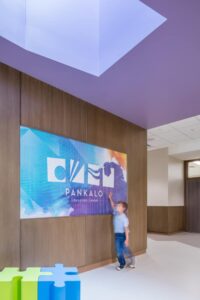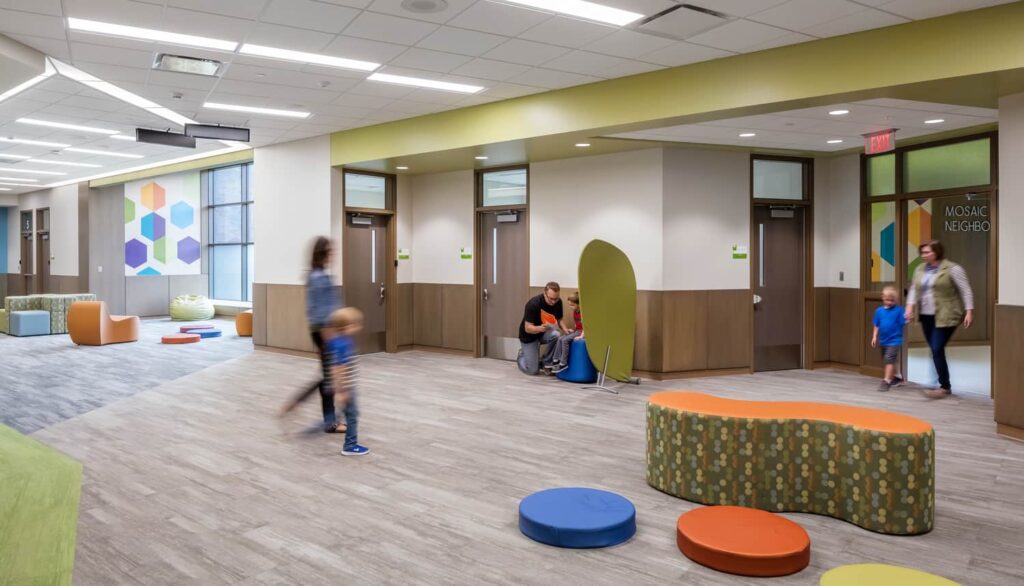Pankalo Education Center, a specialized school serving students with severe autism, emotional-behavioral disorders, and development cognitive disabilities, recently received the Grand Prize Award in an education showcase presented by Learning by Design magazine.
Learning by Design, produced in partnership with the American Institute of Architects’ Committee on Architecture for Education, the Association for Learning Environments, and the Society for College and University Planners, announced the award in the Spring 2019 edition. Pankalo was one of four schools to be recognized through a juried showcase.
 Opened in 2017, Pankalo is operated by Northeast Metro ISD 916, an intermediate school district serving a consortium of 17 districts located throughout the northern and eastern parts of metropolitan Minneapolis-Saint Paul. Using an arts-based focus to its compassionate education model, the education center combines philosophies in education and behavioral health to serve up to 130 students who struggle in traditional school environments.
Opened in 2017, Pankalo is operated by Northeast Metro ISD 916, an intermediate school district serving a consortium of 17 districts located throughout the northern and eastern parts of metropolitan Minneapolis-Saint Paul. Using an arts-based focus to its compassionate education model, the education center combines philosophies in education and behavioral health to serve up to 130 students who struggle in traditional school environments.
In the award announcement, judges noted the school’s “attention to detail to mitigate issues in the special student population.” Those details range from reducing the use of artificial lighting to the location of mechanical units and air ducts that could adversely affect students with heightened sensitivities to light, air, noise, and smell.
Pankalo – a name created from the Greek words meaning “complete” and “beauty” – is designed around four neighborhood communities, each with five classrooms and a common area. The neighborhoods also include other small rooms like a sensory room that allows a student to refocus their minds and bodies and return to classrooms ready to learn.
Beyond the neighborhoods and floor plan that make the design unique and effective, the key to the success of the educational/behavioral combination design are the layers of interventional spaces for students learning coping skills for self-regulation:
- The common areas provide room for students to pace and move without disruption to the other learning environments inside the classrooms or in other neighborhoods.
- Sensory rooms feature student-chosen LED lighting, music, and sounds designed to calm students and help them self-regulate.
- Shorter hallways control sight lines to obscure exits and discourage students looking for an “escape” from running through the corridors.
- Intervention rooms allow staff to work with students one-on-one in a controlled setting with limited distractions.
Working with state fire inspectors, even fire alarms are specific for this special student population, replacing loud alarms and strobe lights with calm voice alarms and LED reader signs more often found in mental health facilities.
Not specific to Pankalo, the fire alarms were one of many successful strategies that carried over from Karner Blue Education Center, the school district’s first school to take a non-traditional approach to the learning environment. Other strategies included soft, movable, child-friendly furniture; rubber flooring and strategically used carpeting; and nesting windows, at Pankalo made deeper for students to sit inside.
The details, layers of intervention, and passive seclusion opportunities help students learn how to manage their bodies and minds through self-awareness and control. They also reduce the physical interventions with staff and create a less disruptive school setting by not challenging the students on a day-to-day basis.
Click to read about Human-Centered Safety® strategies that shaped Pankalo as well as an interview with Northeast Metro’s superintendent, Connie Hayes.








